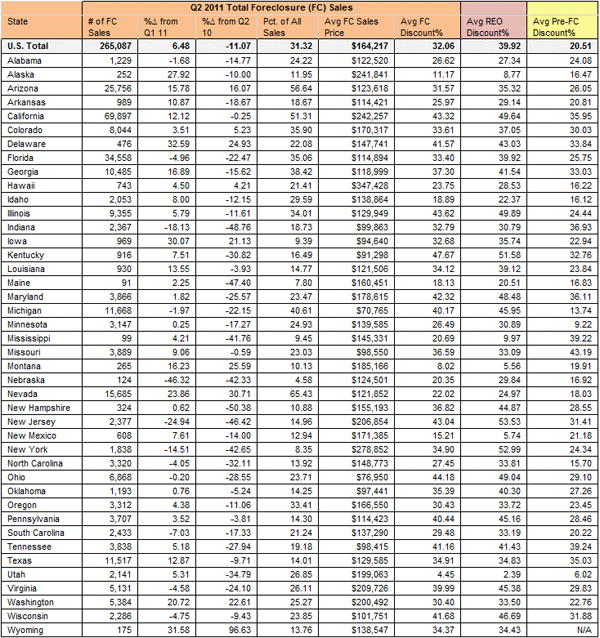RealtyTrac, the Irvine California firm that reports on all things foreclosure said on Thursday that, while sales of bank-owned real estate and homes in some stage of foreclosure during the second quarter of 2011 was mixed in comparison with earlier quarters, the gap in sales price between distressed and market rate sales continued to widen.
Sales of properties that were either sold out of bank inventories (REO), at auction, or while in some stage of default through a short or other sale increased 6 percent over revised first quarter sales to a total of 265,087 properties nationwide. This was a decrease of 11 percent from the number sold one year earlier. The market share of distressed homes dropped from 36 percent of all sales in the first quarter but was up from 24 percent one year earlier.
The average sales price of distressed homes was $164,217 in the second quarter, down less than 1 percent from the first quarter and five percent from one year earlier. On average distressed homes sold for 32 percent less than a home that was not in foreclosure compared to a 27 percent discount in Quarter One.
"With average prices on disrtessed real estate trending down and average discounts trending up, this report is clearly good news for well-positioned buyers and investors looking for bargain real estate that will build them wealth in the long term and often cash flow as rental real estate in the short term," said James Saccacio chief executive officer of RealtyTrac. "Maybe less evident, however, is the good news in this report for distressed homeowners looking to sell, and even lenders saddled with large portfolios of delinquent loans.
The report illustrates some significant differences between homes sold while they are in the process of foreclosure - i.e. in default or scheduled for auction - and those in bank inventory. First of all, pre-foreclosure sales were up sharply, increasing 19 percent from the first quarter to 102,407 properties while REO sales were stalled at 162,680 transactions, only about 200 fewer than in the first quarter. Year-over-year pre-foreclosure sales were down 12 percent and REO sales declined 10 percent. Pre-foreclosure sales accounted for 12 percent of all real estate sales in the second quarter, unchanged from Q1 and up from 10 percent one year earlier. REO sales had a 19 percent market share in the second quarter compared to 23 percent in the first quarter and 15 percent in Q2 of 2010
Pre-foreclosures, which are often sold via short sale where the bank agrees to a smaller payoff than the actual loan balance, had an average sales price nationwide of $192,129, a discount of 21 percent below the average sales price of non-foreclosure homes. That discount was up from a 17 percent discount in the previous quarter and a 14 percent discount in the second quarter of 2010. REOs had an average sale price of $145,211, nearly 40 percent below the average market price. This is an increase from the 36 percent discount that was the average in Q1 and a 34 percent discount one year earlier.
Pre-foreclosures sold in the second quarter took an average of 245 days to sell after receiving the initial foreclosure notice, down from an average of 256 days in the first quarter - following three straight quarters of increases in the average time to sell pre-foreclosures. REOs took an average of 178 days to sell after being foreclosed, an increase of two days since the previous quarter and 14 days more than in the second quarter of 2010. This REO marketing time, however, is on top of the time it took the bank to foreclosure and take possession of the property.
Saccacio said, "The jump in pre-foreclosure sales volume coupled with bigger discounts on pre-foreclosures and a shorter average time to sell pre-foreclosures all point to a housing market that is starting to focus on more efficiently clearing distressed inventory through more streamlined short sales - at least in some areas. This gives distressed homeowners who do not qualify for loan modification or refinancing - or who are not interested in those options and want to sell - a better chance of completing a short sale to avoid foreclosure. Streamlined short sales also give lenders the opportunity to more pre-emptively purge non-performing loans from their portfolios and avoid the long, costly and increasingly messy process of foreclosure and the subsequent sale of an REO - which may end up selling for a lower price than it would have as a pre-foreclosure short sale and in the meantime further stresses already overloaded REO departments."

Foreclosure-related sales accounted for 65 percent of all residential sales in Nevada during the second quarter, the highest percentage of any state. Third parties purchased a total of 15,685 homes in foreclosure or bank owned during the second quarter, up 24 percent from the first quarter and up 31 percent from the second quarter of 2010. The average discount in Nevada was just over 22 percent.
In Arizona distressed property sales accounted for 57 percent of sales at a discount of 27 percent. In California the market share jumped to 57 percent, a 12 percent increase over in Q1, returning the state to the same level as one year earlier.
The states with the largest price differential between market and foreclosure sales were Kentucky (48 percent) and Ohio (44 percent). California, Illinois, and New Jersey all reported discounts over 43 percent. Two states, Montana and Utah, reported average discounts in the single digits. Utah, which is consistently among the states with the highest level of foreclosure activity, reported a discount of 4.5 percent and 2.39 percent for properties sold from REO. RealtyTrac does not offer any explanation for this anomaly.







